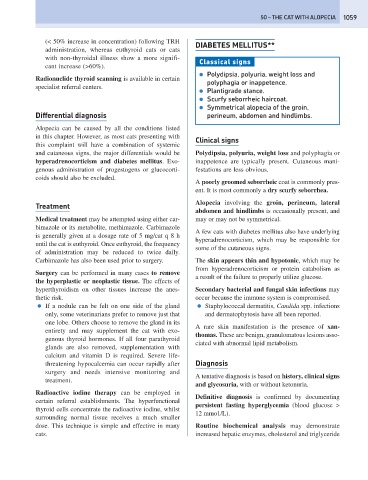Page 1067 - Problem-Based Feline Medicine
P. 1067
50 – THE CAT WITH ALOPECIA 1059
(< 50% increase in concentration) following TRH
DIABETES MELLITUS**
administration, whereas euthyroid cats or cats
with non-thyroidal illness show a more signifi-
Classical signs
cant increase (>60%).
● Polydipsia, polyuria, weight loss and
Radionuclide thyroid scanning is available in certain
polyphagia or inappetence.
specialist referral centers.
● Plantigrade stance.
● Scurfy seborrheic haircoat.
● Symmetrical alopecia of the groin,
Differential diagnosis perineum, abdomen and hindlimbs.
Alopecia can be caused by all the conditions listed
in this chapter. However, as most cats presenting with
Clinical signs
this complaint will have a combination of systemic
and cutaneous signs, the major differentials would be Polydipsia, polyuria, weight loss and polyphagia or
hyperadrenocorticism and diabetes mellitus. Exo- inappetence are typically present. Cutaneous mani-
genous administration of progestogens or glucocorti- festations are less obvious.
coids should also be excluded.
A poorly groomed seborrheic coat is commonly pres-
ent. It is most commonly a dry scurfy seborrhea.
Alopecia involving the groin, perineum, lateral
Treatment
abdomen and hindlimbs is occasionally present, and
Medical treatment may be attempted using either car- may or may not be symmetrical.
bimazole or its metabolite, methimazole. Carbimazole
A few cats with diabetes mellitus also have underlying
is generally given at a dosage rate of 5 mg/cat q 8 h
hyperadrenocorticism, which may be responsible for
until the cat is euthyroid. Once euthyroid, the frequency
some of the cutaneous signs.
of administration may be reduced to twice daily.
Carbimazole has also been used prior to surgery. The skin appears thin and hypotonic, which may be
from hyperadrenocorticism or protein catabolism as
Surgery can be performed in many cases to remove
a result of the failure to properly utilize glucose.
the hyperplastic or neoplastic tissue. The effects of
hyperthyroidism on other tissues increase the anes- Secondary bacterial and fungal skin infections may
thetic risk. occur because the immune system is compromised.
● If a nodule can be felt on one side of the gland ● Staphylococcal dermatitis, Candida spp. infections
only, some veterinarians prefer to remove just that and dermatophytosis have all been reported.
one lobe. Others choose to remove the gland in its
A rare skin manifestation is the presence of xan-
entirety and may supplement the cat with exo-
thomas. These are benign, granulomatous lesions asso-
genous thyroid hormones. If all four parathyroid
ciated with abnormal lipid metabolism.
glands are also removed, supplementation with
calcium and vitamin D is required. Severe life-
threatening hypocalcemia can occur rapidly after Diagnosis
surgery and needs intensive monitoring and
A tentative diagnosis is based on history, clinical signs
treatment.
and glycosuria, with or without ketonuria.
Radioactive iodine therapy can be employed in
Definitive diagnosis is confirmed by documenting
certain referral establishments. The hyperfunctional
persistent fasting hyperglycemia (blood glucose >
thyroid cells concentrate the radioactive iodine, whilst
12 mmo1/L).
surrounding normal tissue receives a much smaller
dose. This technique is simple and effective in many Routine biochemical analysis may demonstrate
cats. increased hepatic enzymes, cholesterol and triglyceride

